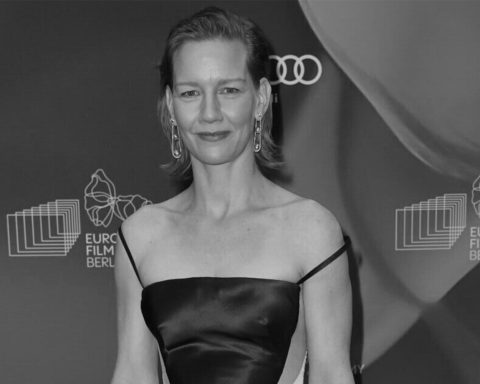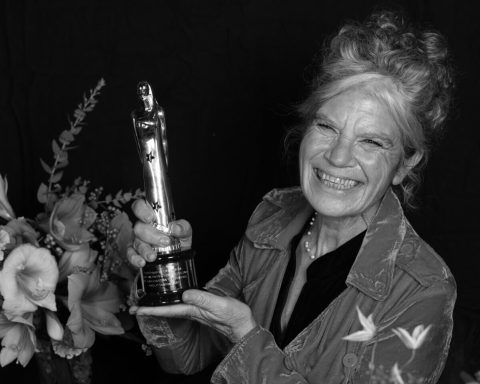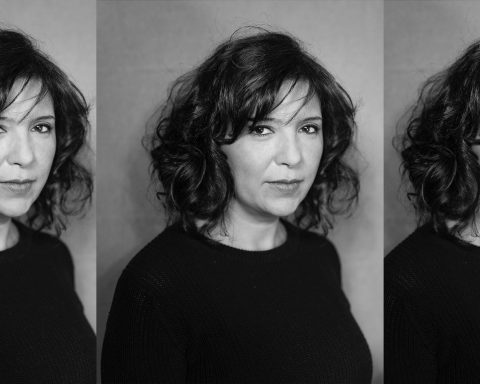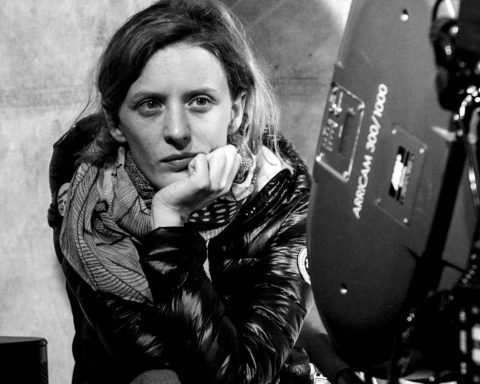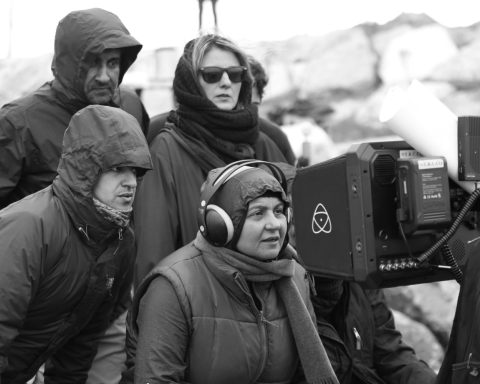Born in Munich, Germany, Ursula Patzak studied scenography at the Academy of Fine Arts in Bologna, Italy. She began her career in 1991 as an assistant to costume designer Moidele Bickel for Peter Stein and Chloè Obolensky’s shows at the Salzburg Festival. Her love for Italy led her to continue her career there. In 1994, she worked on “Richard III” directed by Claudio Morganti, and later on “Lear Opera” and “Totò Prince of Denmark” directed by Leo de Berardinis. Meeting director Mario Martone in 2001 was an important turning point in her career as she worked with him on “The Ten Commandments” and “The Secret Opera” produced by the Teatro Mercadante from Naples, and “Small Moral Works,” “A Night in Colono,” “Carmen” and “Danton’s Death” for Teatro Stabile in Turin. Within the Rossini Opera Festival, Patzak designed costumes for three operas directed by Martone: “Matilde of Shabran” in 2004, also staged four years later at the London Covent Garden, “Torvaldo and Dorliska” and “Aureliano in Palmira.” Many other operas and plays followed.
In 2009, she ventured in the world of costume design for film, working on “Noi credevamo” directed by Martone, that earned her the David di Donatello and Ciak d’oro in 2011. She also designed costumes for “Acciaio” by Stefano Mordini and “Un giorno speciale” by Francesca Comencini. In 2015, her work on “Il giovane favoloso” directed by Martone was awarded once again the David di Donatello and Ciak d’oro. In 2018, she worked on “Capri revolution” again directed by Martone and won, once again, the David di Donatello.
Tara Karajica caught up with her at this year’s Tallinn Black Nights Film Festival, where she gave a masterclass on creating a period film with authentic costumes within the framework of EFA masterclasses at Industry@Tallinn, a new Creative Gate training program intended for film professionals, art department students and those interested in costume design, production design, make-up, hair, visual effects and fashion.
Have you always known you wanted to be a costume designer? How did you become one? How did you get into film?
Ursula Patzak: No, I wasn’t thinking of becoming a costume designer when I was young. I went to an Arts high school in Germany, then to a private fashion school in Milan and then, I studied Set Design at the Academy of Fine Arts in Bologna. Afterwards, I went to Rome to work in different costume departments to learn everything about costumes in order to become an assistant. Then, I met the Italian director Mario Martone and became his costume designer. I started working with him in the theater and on operas and in 2008, he entrusted me with the creation of the costumes for his historical film Noi credevamo, which was my first film.
So you work in theater, in the opera and on film. Which one do you prefer? What is the difference in terms of the work process?
U.P.: Yes, I work in all three mediums. The big difference is that in film, you have close-ups, so you have to be very precise in the details of the costumes. You have to think about every button because it will be seen on the screen. In theater, you have to think about the distance between the audience and the stage and every time you create, you have to imagine the whole stage.
What triggers your creativity and what inspires you when you are working on a costume? How do you get in the zone and what is your work process?
U.P.: I can be inspired by everything, including people on the street. If you work with historical costumes, you have to have a lot of references such Art History and paintings, or photography. I also watch a lot of films that talk about the century I have to deal with. Usually, I take these references to research the characters I have to create. Also, a color or a small detail that I find in the references can later inspire the character.
In your opinion, how does a costume help the director tell his story and complete a character? Do you fight for your vision?
U.P.: Above all, the costume should help the actor get into his/her character and, consequently, help the director tell his story. I try to fight for my vision, but it also depends on the director I work with. Most of them have a precise vision and image of their film and you have to follow their ideas. I could suggest them ideas, but at the end of the day, it is the director’s film…
Do the actors have a say/input in the costumes when you are creating their costumes and therefore their characters? If so, to what extent? How crucial are the clothes in helping them get into a role?
U.P.: Normally, I speak with the actors about the costumes because the costume should help them get into their role. So, for me, it is very important to hear their opinion on their character and the idea they have of their role. Making costumes is not about dressing the actor well or giving them a nice costume, it’s about helping them feel the role they have to interpret.
How close do you work with the make-up department when you are creating a costume?
U.P.: It’s very important to work very closely with the make-up department because you have to create the character together with the make-up artists and hair stylists. The character is not only a dress, but it’s the combination of costume, hair and make-up. A lot of times, it’s the costume that also inspires the make-up and the hairstyles and you create something together.
Your focus is on period costumes. Can you talk about that choice? How do you research a particular period for a costume? How important is historical accuracy? What is your opinion on the relationship between film and history in that sense?
U.P.: I think it’s not really a choice. I love creating historical costumes because I have the possibility to transform people. Sometimes, they become paintings from the past because they have ancient traits. This is really exciting. In terms of research, I look at paintings, photos and I watch a lot of films. Often, I also have to read books about a certain century, a certain way of life and the customs of a certain century. Historical accuracy is very important. Every era has its own color palette, its own specific volumes and shapes. In order to recreate an era, you have to respect the characteristics of that particular era. For instance, the 17th Century has a different color palette and volumes from the 1930s. So you have to also choose the right fabrics to get the desired effect. A film is always a point of view of the historical events. For example, a film about the French Revolution can be the point of view of the poor people or the point of view of the aristocrats. So, surely, there would be two different films…
What are the main faux-pas in costume design in terms of fabrics, techniques, etc? What are the challenges?
U.P.: One of the main faux-pas could be to choose the wrong fabric to make a costume. As I have just told you, it’s very important to know the different types of fabrics and what effect they have when you create a costume. For the 17th Century, I must choose a different fabric than for the 1930s because the volume and the shape are completely different and it’s the fabric that gives you the right volume for a specific era.
How is costume design in the Italian industry? How has it changed since the glory days of Cinecittà?
U.P.: Costume design now is completely different from the glorious 1950s. Today, it’s impossible to create costumes like those for a Visconti or a Fellini film. There’s always less time and less money to design costumes, so we always have to find new solutions to spend less money. But I think it’s a quite common situation in Europe.
What do you think of the underrepresentation of costume design in the film industry at large?
U.P.: I think there’s generally an under-appreciation of the work of costume designers and most of all, in historical films. Instead, I think that costumes are a fundamental element in the creation of the imagery of a film.
There has been a lot of talk about women in film in the past two years. What is your opinion on the matter? How is it in Italy? And, in costume design?
U.P.: I think that there are many talented women not only in the film industry, but they have to fight more to be recognized and respected. And the situation is similar in costume design.
Who is your favorite female filmmaker? And who would you like to work with?
U.P.: My favorite female filmmaker is Jane Campion. There are many filmmakers I would like to work with…
Who inspires you in costume design?
U.P.: I think the greatest costume designer is Piero Tosi, but there are many great costume designers I look up to and try to learn from like Sandy Powell, Milena Canonero, Maurizio Millenotti, Danilo Donati, Coleen Atwood or Alexandra Byrne.
What film that you have worked on are you most proud of? And your best memory of working on a film or on set?
U.P.: The film I am proudest of is Il giovane favoloso for both the costume and the set designs.
What are your next projects?
U.P.: My next projects are a film about Edoardo Scarpetta, the father of Edoardo de Filippo, the most important theater writer in Italy, and the opera Fedora at La Scala in Milan.
This interview was conducted at the 2019 Black Nights Film Festival.
Photo credits: Black Nights Film Festival.






